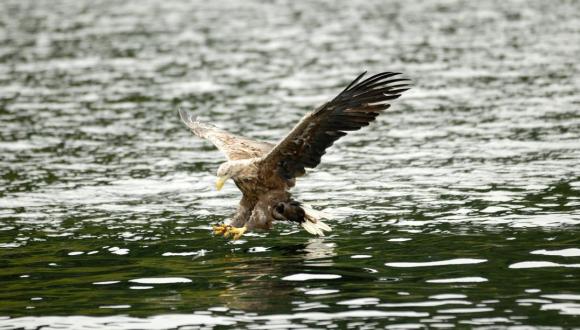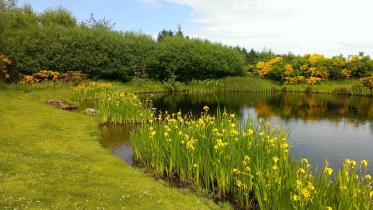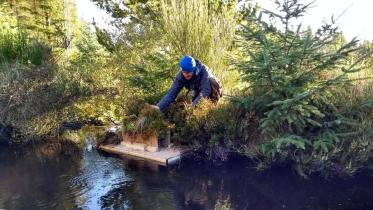Sea Eagle Management Scheme - Annual Report 2022
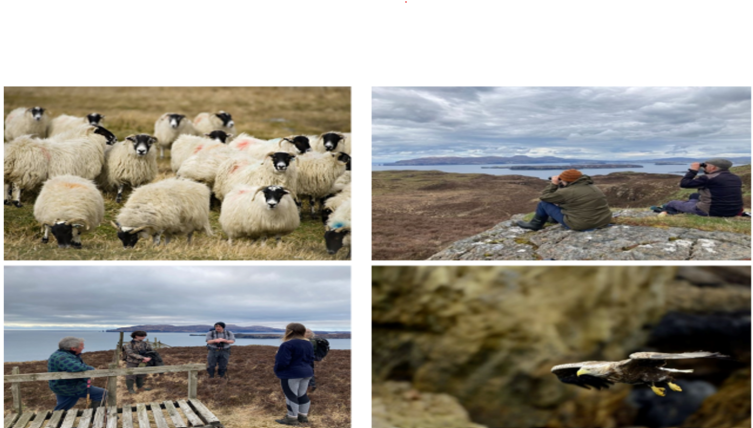
Summary
The reintroduction of white-tailed eagles (WTE) or sea eagles, as they are often known, to Scotland has been a conservation success story. The reintroduction however, has not come without challenges and it is widely acknowledged that sea eagle predation of livestock is a serious issue for farmers and crofters in some areas.
Sea eagle predation of livestock is a complex wildlife management issue and the Sea Eagle Management Scheme (SEMS) run by NatureScot; attempts to better understand this issue and mitigate impacts where they occur. In 2022, 158 holdings covering an area in excess of 143,000 hectares and with responsibility for over 66,500 breeding ewes and gimmers received Management Agreement (MA) support from the SEMS.
MA support provided by the SEMS in 2022 varied and alongside area-based support, 38 holdings received additional support in the form of enhanced or capital measures. Support at this level was targeted at those holdings experiencing the most significant issues and those who have made significant management changes to mitigate issues, with resultant costs to their businesses. These MAs were tailored to the farmer or crofter’s individual management system and required close collaboration between SEMS staff and farmers and crofters. Enhanced MAs also included support to 11 holdings for enhanced shepherding, a collaborative measure targeted at more extensive areas, with a separate report on that work in preparation.
In addition to MA support, NatureScot provided support to farmers and crofters through its Call off Contractor and Observer team in 2022, with a range of fieldwork carried out. Total spend on the SEMS and associated work in 2022 was £291,035.60.
This annual report provides an overview of SEMS support in 2022, highlights key areas of fieldwork delivered and feedback from some participating holdings on SEMS support.
1. Introduction
The Sea Eagle Management Scheme (SEMS) provides advice and support to farmers and crofters concerned about or experiencing livestock predation by white-tailed eagles or sea eagles, as they are often known.
It is widely acknowledged that in some places, sea eagles predate live, healthy lambs and the impact on farmers and crofters livelihoods can be significant. The issue of livestock loss is complex and the impacts extend beyond the direct loss of individual animals.
Predation on hill flocks, which rely on recruitment to the flock adapted to that environment and hefted to that place, can adversely affect the sustainability of the whole livestock system. Changes to the flock age structure and the loss of genetic characteristics from the flock are all impacts that can be experienced as a result of lamb loss.
NatureScot, through the SEMS, is working closely with farmers, crofters, and a range of stakeholder partners to try to mitigate impacts where they occur. NatureScot runs the SEMS on behalf of the National Sea Eagle Stakeholder Panel (NSESP), which is comprised of representatives from the following stakeholder organisations:
- NatureScot,
- National Farmers Union of Scotland
- National Sheep Association Scotland
- Scottish Crofting Federation
- RSPB Scotland
- Forestry and Land Scotland
- Scottish Government Rural Payments and Inspections Directorate
- Scotland's Rural College
- Scottish Raptor Study Group
NatureScot have administered a national SEMS since 2011, with local schemes operating prior to that in the West Highlands and Mull. There is a range of different support offered by the SEMS, which includes advice from the NatureScot call off contractor team, loan of scaring equipment, and financial support in the form of Management Agreements (MAs).
The purpose of this annual report is to provide stakeholders with a summary of the work delivered as part of the SEMS in 2022.
2. SEMS support delivered in 2022
2.1 Call off contractor Register of Interest (Rol) visits
NatureScot contract a team of call off contractors on an annual basis, who have expertise in sea eagle ecology and a detailed knowledge of farming and crofting systems. After initial discussions with NatureScot SEMS staff, the first point of contact for farmers and crofters after submitting a RoI in the SEMS is usually one of the call off contractor team.
Currently there are seven members of the call off contractor team, each covering a broad geographical area across the core areas where the SEMS is working - principally Argyll and Lochaber, Skye and Lochalsh, the Western Isles, Sutherland and Wester Ross. As the sea eagle population expands, call off contractors have also provided advice and support to farmers in other areas such as Perthshire, Angus and Strathspey.
Following the submission of a new RoI, the relevant call off contractor will be assigned to the farm, croft or sheep stock club registering their interest. A site visit, where possible, will be arranged with the point of contact, to provide advice and discuss in more detail any issues being experienced. The initial site visit also allows information on the holding’s management system to be discussed in more detail, with advice tailored to that specific situation. Call off contractors are also able to provide an overview of sea eagle territories in the surrounding area.
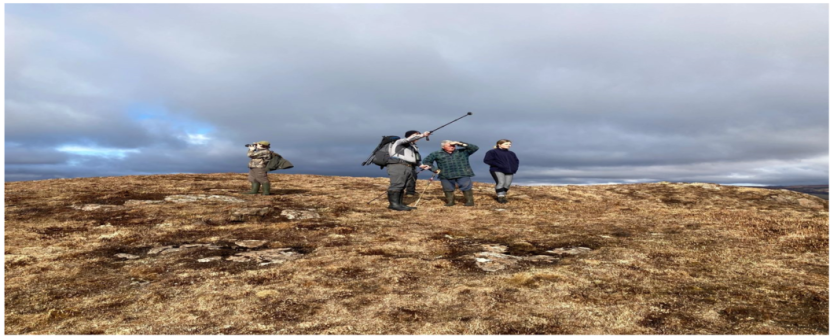
The nature of new RoIs varies with some farmers and crofters seeking advice only, some seeking loan of scaring equipment and some looking for advice on options and support available from SEMS MAs.
In 2022, the call off contractor team responded to 34 new register of interests in the SEMS, with site visits carried out for the majority of these following initial contact with the scheme. The farmers and crofters represented by these new RoIs manage land in excess of 10,700 hectares, with responsibility for over 8,800 breeding ewes and gimmers. Figure 2 below provides an overview of the location of these holdings:
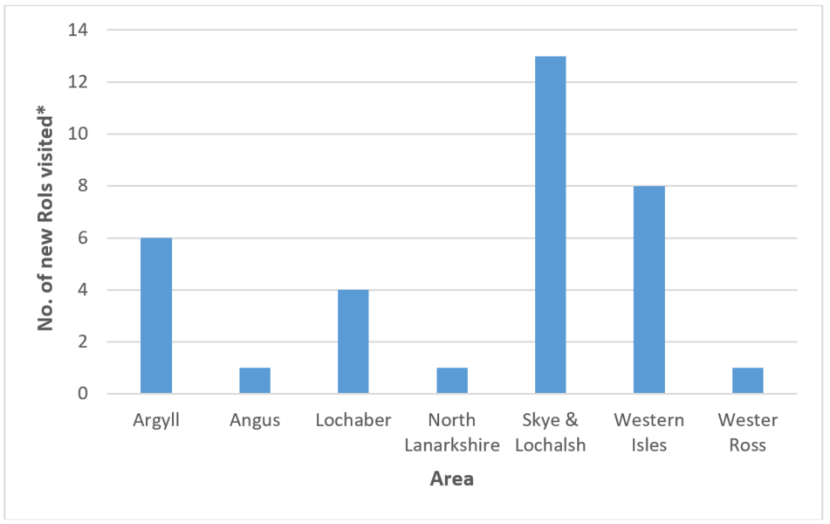
Graph showing the number of new RoIs visited* compared with Area.
- Argyll: 6
- Angus: 1
- Lochaber: 4
- North Lanarkshire: 1
- Skye & Lochalsh: 13
- Western Isles: 8
- Wester Ross 1
In addition to new RoI visits, the call off contractor team and NatureScot SEMS staff completed a significant number of site visits during 2022, liaising with existing participants in the SEMS and delivering fieldwork; some of which is discussed later in this report.
2.2 Scaring equipment loans
NatureScot have an inventory of scaring equipment, which is available to loan to farmers and crofters during lambing in order to try to mitigate sea eagle predation issues. Experience from trials has shown that this scaring equipment is most effective on holdings where lambing is taking place in-bye, in smaller lambing parks.
There are a number of holdings participating in the SEMS, particularly in the Western Isles, where scaring equipment is found to be an effective mitigation method against sea eagle predation of lambs, as well as deterring other avian predators. In order to ensure that scaring equipment is available for trial to a wider group, NatureScot have encouraged those who have felt this to be an effective tool to apply to the SEMS for support for the purchase of these items. In 2022, eight holdings loaned scaring equipment from NatureScot, with the majority of these holdings located in the Western Isles.
2.3 SEMS MA support
In addition to providing advice and loans of scaring equipment, the SEMS also provides financial support to farmers and crofters experiencing sea eagle predation, or taking action to mitigate the risks of predation through NatureScot MAs. As referenced in the 2021 Annual Report, the way in which financial support from the SEMS is administered changed significantly in 2020 following consultation with local and national sea eagle stakeholder groups. The standard level of support calculated on area was still maintained, however enhanced and capital measures support was introduced to SEMS MAs. This support is targeted at those experiencing the most significant issues and those who have made significant management changes to mitigate issues, with resultant costs to their businesses.
In 2022 there were 158 holdings receiving MA support from the SEMS, which included 21 new applicants seeking MA support. The farmers and crofters represented by these holdings manage land in excess of 143,000 hectares, with responsibility for over 66,500 breeding ewes and gimmers. The majority of these holdings (120) were in receipt of the standard level of support, with 38 holdings receiving enhanced or capital measures support. Table 1 below provides an overview of MA spend in 2022:
|
Support Type |
Spend |
|---|---|
|
Standard Measures |
£128,081.11 |
|
Enhanced and Capital Measures |
£137,899.72 |
|
Total |
£265,980.83 |
More detail on enhanced and capital measures support delivered in 2022 and feedback on this follows.
2.3.1 Enhanced support
In 2022, there were 35 holdings which were offered, or in receipt of enhanced support across Argyll, Skye, Strathspey and the Western Isles. The management supported through enhanced MAs varied, with a range of options available and NatureScot welcoming new approaches and ideas from farmers and crofters. MAs offered were tailored to the farmer or crofter’s individual management system. Support at this level is delivered annually, with MA term length varying depending on the timing of application submission. The maximum level of support offered at this level is £5000 per annum.
In 2022, there were eleven holdings in Argyll, Skye and the Western Isles delivering the enhanced shepherding measure under this level of support, with participating farmers and crofters managing a total area in excess of 9,500 hectares and responsible for in excess of 6,800 breeding ewes and gimmers. Enhanced shepherding is a collaborative measure, introduced in 2020, which is targeted at more extensive areas, where other management options might be limited.
The measure aims to improve understanding of sea eagle predation and other factors influencing lamb loss on these areas, as well as the influence of additional human presence on sea eagle behaviour. More information on enhanced shepherding and a summary report of the 2022 work is in preparation.
Despite a challenging year for some who delivered enhanced shepherding, there was again some positive feedback on this measure, which is evident in the comments below:
Less obvious losses seen this year than previously – this could be due to the fact that the enhanced shepherding and increased presence on the hill (3x a day during lambing) deterred the WTE.
Enhanced shepherding seemed to be helpful (this is the first year of taking part in this scheme) due to it providing the ability to spend longer on the hill. Less WTE were seen this year, which could be due to this increased human presence on the hill.
Enhanced shepherding was useful, as we said before; we feel more human activity on the hill parks was a deterrent to the birds. We would be interested in doing this again.
Across all three areas, we continue to see the greatest loss during lambing time but across all areas, we have seen an improvement in 2022 with the enhanced shepherding measures put in place. The enhanced shepherding was useful this season as it allowed more eyes on the key areas during the critical lambing weeks when we have the greatest lamb losses and highest level of eagle sightings, the increased human presence at such a critical time of year has clearly made a difference.
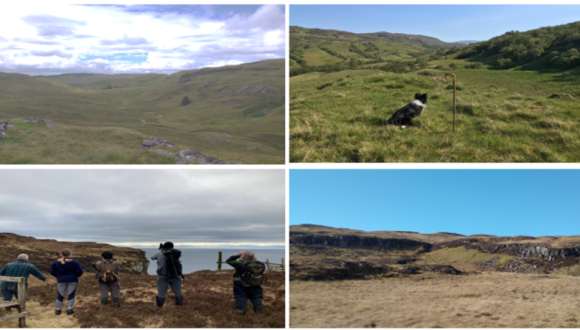
In addition to enhanced shepherding, NatureScot also provided support in 2022 to a number of holdings where changes to historic management practice have been made in an attempt to mitigate sea eagle predation. This included support to ten holdings in Argyll and Skye who have changed the location of some or all of their lambing from hill lambing to indoor lambing - which has resultant additional costs in terms of labour, feed and bedding.
NatureScot also provided support in 2022 to seven holdings in Argyll, Skye and Sutherland, who have changed their management from solely hill lambing, to lambing a proportion of their flock on in-bye fields usually set-aside for silage production. Lambing on these fields has knock on effects on silage yield and resultant bought in feed costs. NatureScot have worked closely with those farmers and crofters to provide financial support in order to address some of these costs through MA contributions specifically tailored to their individual management systems.
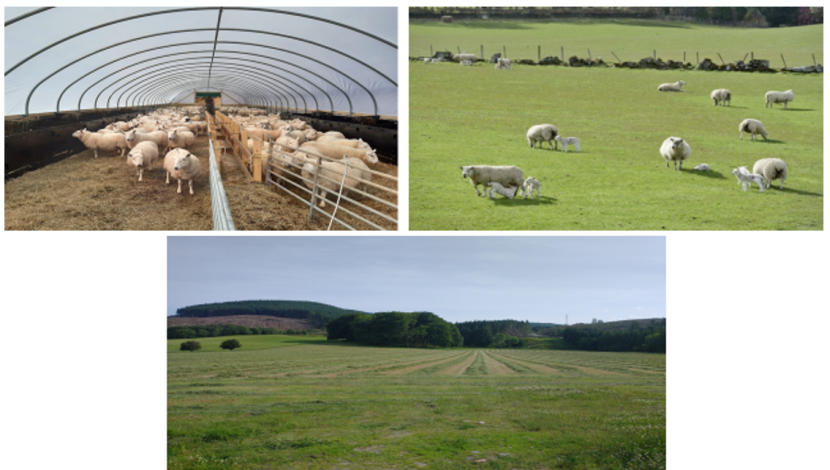
Figure 4: Changes in lambing location from hill to indoor or in-bye can have resultant costs associated with inputs and silage yield and NatureScot have worked closely with farmers and crofters to provide support under enhanced measures to assist with some of these cost.
As well as supporting the above management under enhanced measures, the following measures were also supported in 2022 following applications for support submitted by farmers and crofters across Argyll, Skye and Strathspey:
- Away-wintering of ewes to enhance condition prior to lambing
- Away-lambing or away-summering of ewes and lambs
- Earlier weaning and follow on housing of lambs
As in 2021, farmers and crofters receiving this level of support in 2022 were asked to provide feedback on their enhanced MAs as part of annual end of season reporting.
Those receiving this level of support were asked for comments on whether the management supported had mitigated sea eagle impacts on their holdings, whether the level of support provided was reflective of overall costs associated with management changes and how this new approach compared with the previous area based support.
In addition, feedback was also sought on any suggested changes or improvements. The responses received have been collated and some examples of the feedback provided is detailed below:
For us without the support of the scheme it would not be possible to house the sheep inside, feed costs have risen so drastically over the last year. The Scheme allows us to try new things that could lower the impact the eagles are having.
The scheme reflects more on individuals and their ways of farming, and efforts to manage the issues with Sea Eagles. There will be new innovative ideas that are being funded, and new ideas may help others.
This approach, which supports the only mechanism I have found to work, is effective and much preferred. The away wintering has reduced hot spot issues and increased productivity.
This management option has helped free up in-bye grazing for the ewes through lambing and into the summer which has protected more lambs from predation. Weather conditions and improved spring grass growth also helped during 2022 which has also benefitted the hill lambing.
The new approach is much more proactive and tailored to an individual farm’s needs. It is less prescriptive and allows the project officer to work with each farm business and build a workable plan and positive working relationship which helps deliver for the farm business and for nature.
As well as the positive feedback outlined above there was other feedback which reflected ongoing issues of lamb loss being experienced on some of the holdings receiving enhanced support in 2022, as well as the impact historic losses have had. Feedback also reflected on increases in other costs associated with management changes:
The payment is not reflective of the overall costs but it does help to purchase some replacement hay and silage. Input costs are increasing significantly, and the economic viability of hill farms is coming under increasing pressure. The cattle deliver significant environmental benefits and support packages like this are critical if cattle numbers are to be maintained on hill farms.
The overall support does not go far enough in terms of providing sufficient income to pay for the additional ewe hogg purchases which are required as a result of sustained predation over many years.
This year has been a massive change to the way we used to lamb. Figures would suggest this has been a success, however we are still short of replacements for the hill from the devastation of 2021 and the effects of the impacts in that year will be felt for five years.
We don’t have the same choice as we used to in keeping ewe lambs and we are forced to keep smaller ones in order to keep ewe numbers up. We feel we are quite lucky to get extra support but it could be more as losses are getting bigger as well as costs and inflation should be taken into consideration.
2.3.2 Capital support
As part of the new approach to delivery of SEMS MAs, capital support is available to farmers and crofters wishing to explore infrastructure projects such as the creation of new hill parks, lambing polytunnels and sheds, or carrying out works such as improvements of fields through liming. Depending on MA term, NatureScot offer support in the form of percentage contributions to actual costs of projects, with percentage costs reducing as MA term reduces.
In 2022, NatureScot supported one holding in Argyll and two holdings in Skye with in-bye improvement works in the form of liming or phosphate application in order to improve in-bye pasture and allow longer retention of ewes and lambs in-bye.

Figure 5: Improvement of in-bye pasture can help retain ewes with twin lambs on these areas for longer with twin lambs being more susceptible to predation
3. Associated support from the SEMS in 2022
3.1 NatureScot SEMS observer team
In 2022, the NatureScot SEMS observer team delivered additional observations on five farms in Argyll and one in Lochaber, including working collaboratively with farmers on three farms in Argyll that were delivering the enhanced shepherding measure. Eleven observers made up this team in 2022, with call off contractors providing support and training to newly contracted team members and introductions to the farms and farmers.
Observations commenced in April and finished in August, with observers delivering a combination of vantage point work and walking routes on the hill. Observers collected data on sea eagle activity as well as the activity of other lamb predator species, presence of other sea eagle prey species and observations of carcasses and potential predation signs. Observations took place at varying times from early morning through to evening, with over 350 hours delivered across the five farms.
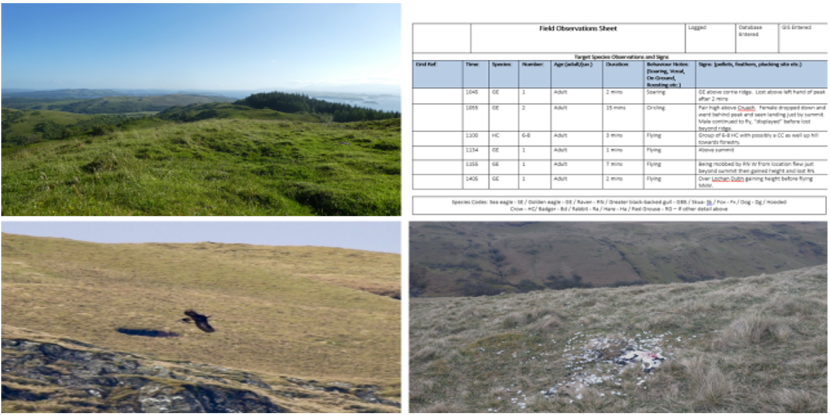
Figure 6: Vantage points (top left) and walking routes were used to deliver observation work with observations of other potential predators of lambs such as golden eagle (bottom left) recorded in addition to observations of lamb carcasses showing signs of eagle predation (bottom right)
Whilst also supporting farmers and allowing co-ordination of enhanced shepherding work on three farms, these observations helped support remote camera trapping work taking place on three of the farms. On two farms in Argyll, sea eagles were observed leaving lamb carcasses showing signs of predation. Lamb carcasses showing signs indicative of eagle predation were recorded on four of the five farms where additional observations took place in 2022. The data collected from this work will be collated and presented in the enhanced shepherding report, which is in preparation.
3.2 Liaison and fieldwork
In addition to completing site visits associated with new RoIs, the call off contractor team and NatureScot SEMS staff liaised with existing SEMS participants throughout 2022, with a number of site visits completed as well as provision of advice and discussion of queries by email and telephone. This work also included liaison with local and national stakeholder representatives and responding to media enquires related to the SEMS.
In addition to direct observations delivered in Argyll and Lochaber by observers and call off contractors, trail cameras were deployed on two farms in Argyll and one in Lochaber in 2022. This work was carried out in an attempt to understand the age class of sea eagles using these areas, as well as the presence of other predator and prey species and potential sea eagle interactions with lambs.
The cameras deployed recorded a significant number of images and time-lapse video, with analysis of this work ongoing for two holdings. At one of the Argyll holdings, this work has been completed with the ten cameras there deployed between February and November 2022.
Eight of the cameras deployed at this holding were located on the hill ground, overlooking crags and knolls, with two initially covering some of the in-bye lambing areas. The cameras were checked a few times during the season, with the two in-bye cameras relocated to the hill ground following turnout of ewes and lambs from this area.
The cameras recorded over 110,000 images with a significant number of these again being of moving vegetation, with cameras again knocked over or their position altered by lambs as the images in Figure 7 below demonstrate:
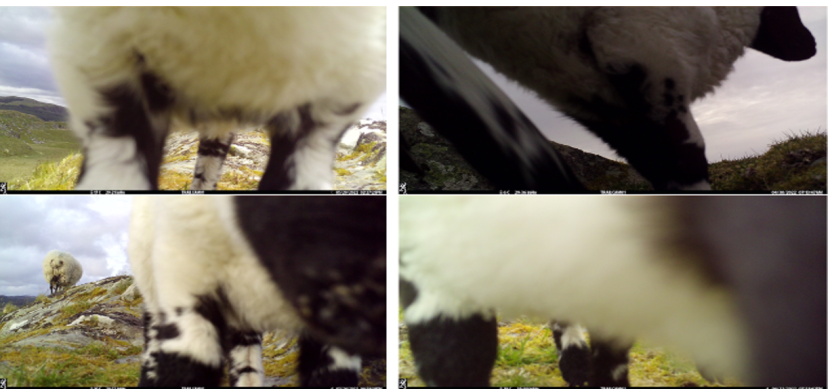
Despite this, at this farm, the cameras did record a number of different species – 23 in total, however in 2022 there were no white-tailed eagle (WTE) recorded on the cameras. The cameras recorded five images of golden eagle in 2022, likely an individual or individuals from a nearby pair, detailed in Figure 8 below:
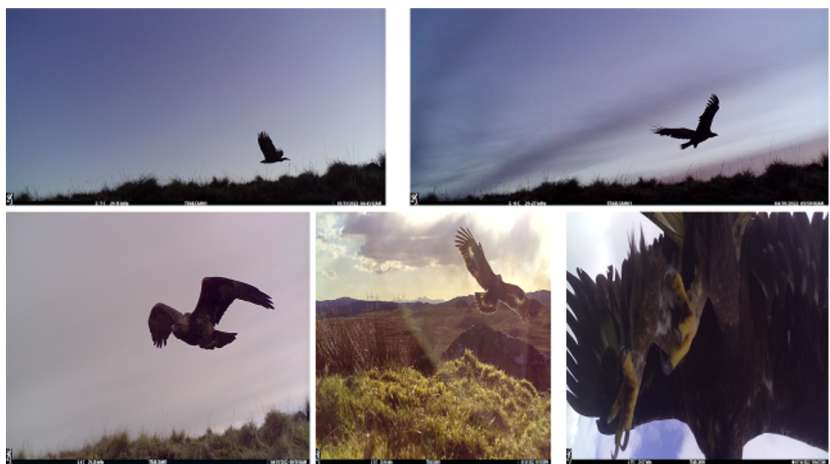
In addition to golden eagle, there were other potential predators of lambs recorded on the cameras during 2022 as detailed in Figure 9 below:
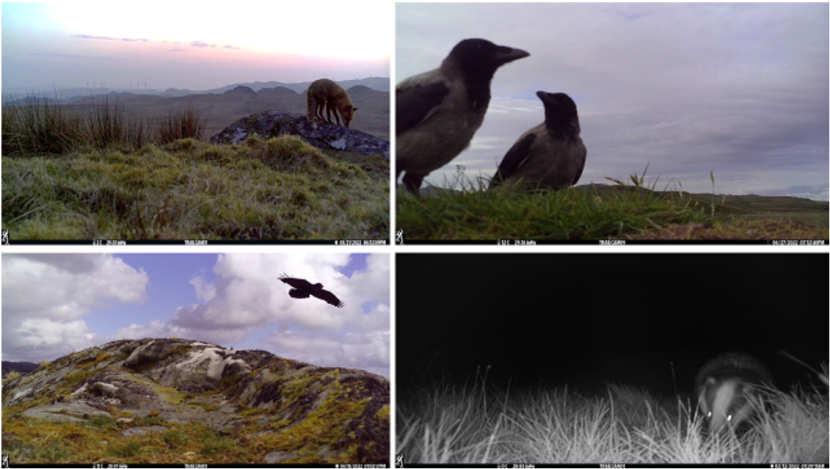
With the use of thermal imaging equipment, this farm has observed predation of young lambs by badgers in previous seasons at this location, although the extent of their involvement in overall lamb losses at this location is not fully understood. Both foxes and hooded crows are managed to mitigate lamb predation issues, with ravens not considered a significant issue at this holding.
In addition to recording potential predators of lambs, the cameras at this location also recorded hen harrier and black grouse, two red listed species, as detailed in Figure 10 below, with this location being an important lek site for black grouse, which have experienced population declines across other areas of Argyll.
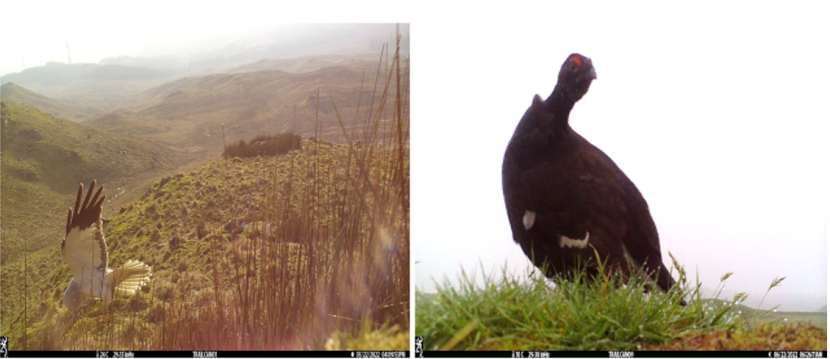
In addition to camera trapping work on farm, a trail camera was installed on a WTE nest in Skye under licence by call off contractors in an attempt to understand prey selection and timing by this pair and monitor breeding activity. The WTE pair accepted this camera with over 1100 time-lapse video clips recorded. The adults were present at the nest from the 27th of November 2021, when nest maintenance commenced. Material continued to be added to the nest up until mid-March when molinia was brought in to line the nest prior to the female sitting. The images in Figure 11 below demonstrate the early and late nest maintenance work:
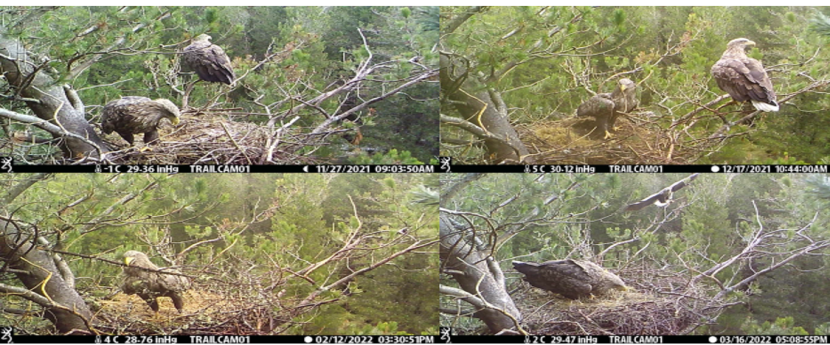
The first of two eggs laid was visible from the 24th of March with the second egg visible from the 28th of March. The season’s poor weather was recorded on the camera with snow at the end of March and beginning of April and persistent heavy rain, at times accompanied with high winds evident in April and May. The first images confirming successful incubation were on the 3rd of May when one of the two eggs hatched with the first images of the second chick on the 5th of May as illustrated in Figure 12 below:
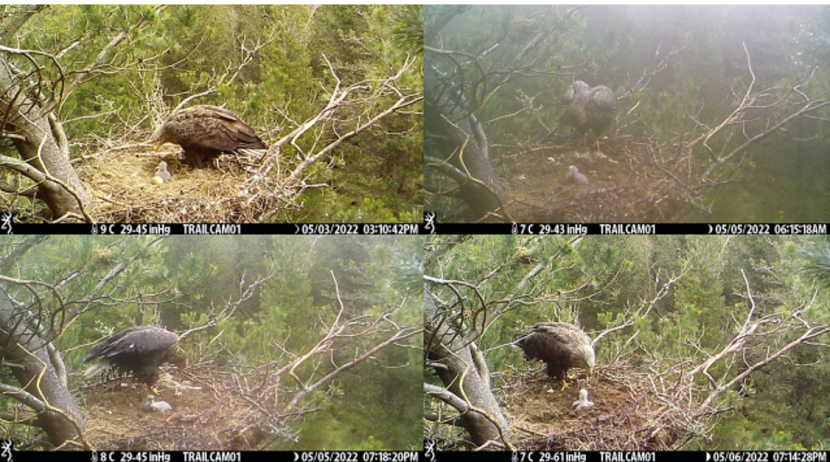
The camera recorded some prey items being brought to the nest, with the majority of these items not being identifiable. The camera captured one occasion of the adult arriving at the nest with the remains of a bloodied lamb in its talons with this lamb shown in the top two images of Figure 13 below. Another lamb was also evident on the nest during the first week of May although the camera did not record this being brought in, with this lamb visible on the bottom two images.
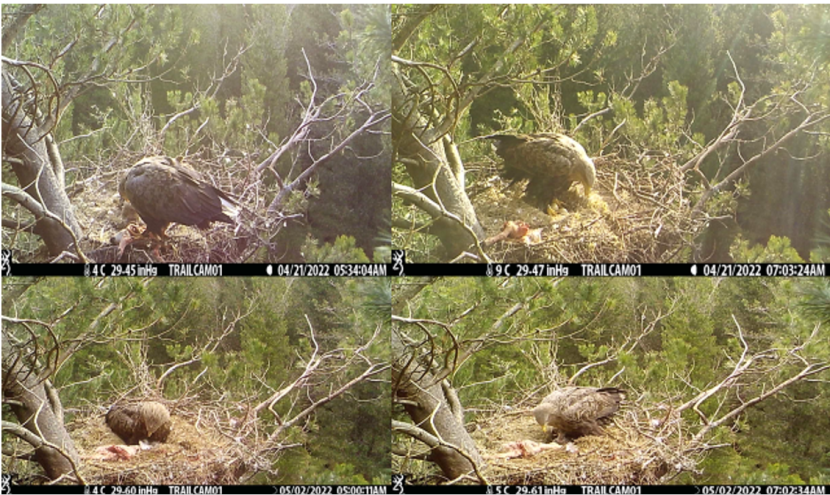
Figure 13: Evidence of lambs on the nest with the lamb shown in the top two images brought in bloodied by one of the adults. Another lamb potentially a Cheviot was evident on the nest during the second week of May as seen in the bottom two images.
Poor weather continued in to May with the camera recording the adverse weather conditions and the soaked adult sitting on the nest. The nest failed around the 10th of May, perhaps because of the poor weather conditions. More molinia was brought to the nest following the failed attempt, with visits to the nest by the adults then becoming less frequent and the nest being abandoned by the time the camera was retrieved during productivity checks in June. Due to the birds accepting this camera, it was reinstated in the autumn and will record activity at this site in 2023.
In order to understand sea eagle prey selection and availability in some areas reporting ongoing predation of lambs, call off contractors had planned to visit a number of sea eagle nests in the autumn of 2022 in Argyll, Angus, Skye & Lochalsh, and Sutherland. Due to the outbreak of avian influenza and potential biosecurity issues, it was decided that this work should be postponed until 2023, where consideration of the avian influenza situation would again be taken into account when planning this work.
4. Concluding remarks and acknowledgements
The return of sea eagles to our skies is a conservation success story. However, in some places sea eagle predation continues to be a serious issue for farmers and crofters. Sea eagle predation of livestock is a complex wildlife management issue and in writing this annual report, the views and feedback of some farmers and crofters have been reflected.
NatureScot recognise the concern and seriousness of this issue to some farmers and crofters across parts of Scotland and continue to work closely with stakeholders at a local and national level to find solutions. The work of the SEMS and the NSESP are examples of the Shared Approach to Wildlife Management being applied in practice.
The shared approach is a way of working together on wildlife management issues, even when opinions differ. At its heart are the principles of how we can work in partnership; respect each other’s views, build knowledge, share information, develop a common understanding, clearly communicate decisions, pursue best practice in animal welfare, and ultimately nurture the best outcomes for people and nature.
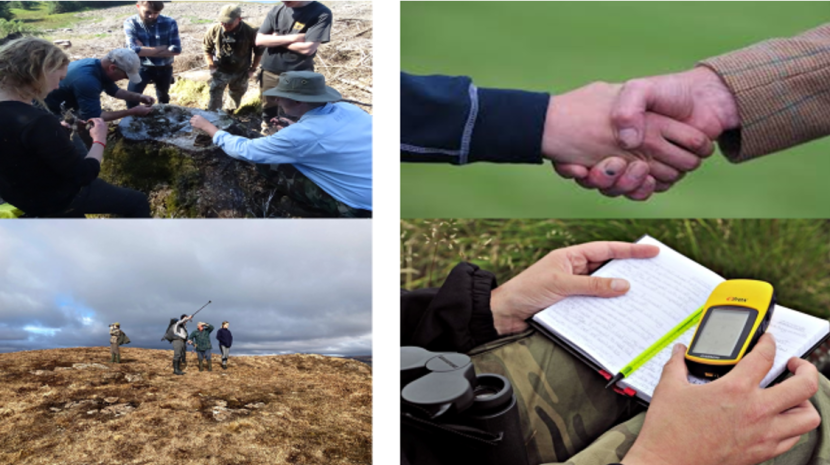
The content of this Annual Report demonstrates the wide variety of desk and fieldwork delivered by the SEMS in 2022. This work has been delivered in collaboration with farmers and crofters across a number of areas of Scotland. This report acknowledges the input and data provided by those individuals and representatives from farming and crofting organisations, principally NFUS, SCF and NSA Scotland.
The report also acknowledges the ongoing work of stakeholder representatives from local and national sea eagle stakeholder groups on this complex issue.
Much of the work delivered in 2022 would not have been possible without the expertise of the call off contractor and observer teams and NatureScot acknowledges their continued work in helping to deliver the SEMS.
Thanks to NatureScot colleagues working on various aspects of the SEMS, from development and delivery of MA support to administration, advice and liaison elements of the SEMS.
